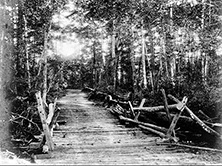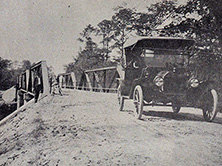 Log road and bridge near New Bern, ca.1900s (courtesy of The State Archives of North Carolina)
Log road and bridge near New Bern, ca.1900s (courtesy of The State Archives of North Carolina) The Good Roads Movement began in the late 19th century as a diffuse nationwide call for better roads and bridges "to get farmers out of the mud."
It had grassroots origins that varied in intensity from region to region. The areas of greatest activity were the Northeast and Midwest, but it was also strong in the countryside surrounding urban areas in the South.
Like many progressive reforms, its strongest proponents were middle-class professionals who believed they could remedy poverty with government programs that improved the infrastructure — sewer, water, parks, hospitals, clinics, schools, and roads and bridges. Good roads and bridges, the reformers claimed, would end rural isolation and lower transportation costs for farmers and small rural manufacturers.
 First bridge built under supervision of State Highway Commission, carrying NC 42 over the Tar River in Edgecombe County, 1916—erected by the Roanoke Bridge Company for $15,641.81 (North Carolina Roadways, January-February 1951) The Good Roads Movement had a profound impact on the history of road and bridge building in North Carolina. It awakened business and political leaders to the idea that bad transportation infrastructure was an ingredient of rural poverty. Reformers gathered evidence that improvements would decrease shipping costs and thus boost the state's agriculture and industry.
First bridge built under supervision of State Highway Commission, carrying NC 42 over the Tar River in Edgecombe County, 1916—erected by the Roanoke Bridge Company for $15,641.81 (North Carolina Roadways, January-February 1951) The Good Roads Movement had a profound impact on the history of road and bridge building in North Carolina. It awakened business and political leaders to the idea that bad transportation infrastructure was an ingredient of rural poverty. Reformers gathered evidence that improvements would decrease shipping costs and thus boost the state's agriculture and industry.
The Good Roads Movement first showed itself in scattered local road and bridge projects, especially in counties that had a large town or city such as Buncombe and Mecklenburg. Some county commissions, once reluctant to raise taxes or invest heavily in roads and bridges, now found reason to do so. They built roads surfaced with crushed stone (macadam), sand-clay, gravel, concrete and asphaltic materials. They contracted out to build bridges.
Many other North Carolina counties, especially those in isolated rural areas of the mountains and coast, did not have the necessary resources to improve their roads and bridges. This convinced many reformers that the federal and state governments should play a role in the financing and construction of statewide highway systems.